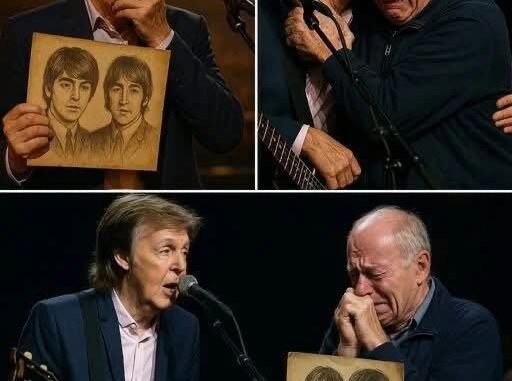
A Hidden Audience Member – And a Message from the One Who’s No Longer Here
New York, July 14, 2025
Last night at Madison Square Garden, in a performance that had already promised nostalgia and history, Paul McCartney delivered something far beyond music. Midway through his set, when the spotlight dimmed and the first gentle chords of “Here Today” floated through the arena — the elegy he wrote for John Lennon decades ago — a ripple moved through the front rows.
There, just beyond the monitors, an elderly man sat almost motionless, except for the trembling of his hands as they held a faded sketch. While 20,000 fans swayed and sang along, the man didn’t mouth a single word. Instead, tears traced silent lines down his weathered face. On his lap rested a yellowed drawing: two young men in their Liverpool days, cross‑legged on a sidewalk, guitars in hand, heads thrown back in laughter.
McCartney noticed.
Those who know him say his eyes wander the crowd during the song, looking for connection. But last night, as he hit the line “But as for me, I still remember how it was before,” his gaze locked on the man in the front row. Something changed in Paul’s voice, a falter just slight enough to make the audience feel it too.
When the concert ended — after encores, after bows, after the roar of a crowd unwilling to leave the magic — Paul asked security to bring the man backstage. The request startled his team; at this stage of his career, such meetings were rare and usually pre‑arranged. Yet minutes later, the man was led into the dressing room, clutching not just the sketch but a worn, cream‑colored envelope.
Witnesses describe the man as soft‑spoken, with the accent of old Liverpool still tucked in his words. His name was never made public. He looked at Paul and said only:
“I was John’s schoolmate. I’ve kept this for 60 years, waiting for the right person to give it to.”
He extended the envelope. Paul, stunned, opened it carefully, as if the paper itself might crumble. Inside was a single page, folded twice, the ink faded but still legible. It was John Lennon’s handwriting, unmistakable to anyone who had worked with him closely: sloping letters, quick, restless strokes.
The lyric on the page read:
“If I go first, don’t cry – I’ll still play rhythm when you sigh.”
For a long moment, no one moved. The man simply stood there, hands clasped, while Paul stared at the page as if trying to bridge decades with his eyes alone. The dressing room, moments earlier filled with chatter and laughter, fell silent enough to hear the distant hum of stage equipment being packed away.
Paul didn’t cry. He didn’t speak right away. He simply lifted his gaze toward the ceiling, toward the sky beyond it — the same night sky that hung over Liverpool when two teenagers first strummed their way into history. His voice, when it came, was soft, almost a whisper, but the crew nearby heard it clearly:
“So you’re still writing, aren’t you…”
It’s impossible to know when Lennon wrote the line or why. Perhaps it was a private note never meant to be found, or perhaps, as some speculate, it was something he drafted in those later years, aware of how fragile life could be. The man who delivered it offered no further explanation. He only said that he had held onto it, waiting for “the right night, the right song, the right look in your eyes.”
By the time he left the venue, slipping quietly into the New York night, the page remained in Paul’s hands.
News of the encounter spread quickly. Within hours, social media flooded with photos of Paul’s performance and speculation about the mysterious lyric. Beatles scholars debated its authenticity, but those close to Paul confirmed that the handwriting, the phrasing, and even the type of paper matched Lennon’s known materials from the early 1960s.
Outside Madison Square Garden the next morning, fans left candles, sketches, and handwritten notes along the steps. One sign read, “Still playing rhythm. Still sighing.” Another, taped to the concrete, simply said, “Thank you, John. Thank you, Paul.”
In an era where legacy often feels like a relic, last night’s quiet exchange reminded the world that the Beatles were never just a phenomenon — they were two boys who sat on a curb with guitars, dreaming songs into being. One is gone. One remains. And somehow, through an envelope carried for six decades, their conversation continues.
Paul has not said whether he will perform the newly discovered lyric. But those who watched him leave the Garden last night say he carried the page tucked inside his jacket, held close against his heart.
And somewhere, perhaps, the rhythm guitar still hums in the night air — softly, faithfully, just as promised.
Leave a Reply